What's new
This page provides information and links to pages recently added to the ‘mineralsUK.com’ website.
United Kingdom Minerals Yearbook 2023 survey
The Minerals area at BGS are very interested to find out who is currently downloading our minerals data or World Mineral Production publication and what commodities you are particularly interested in. We would also like to find out how you would like our data to be presented to you in the future. We would be very grateful if you could spare a couple of minutes to complete our short survey.
United Kingdom Minerals Yearbook 2023
This annual publication by the British Geological Survey provides comprehensive statistical data on minerals production, consumption and trade to 2022. It is of value to all those interested in the many facets of Britain's minerals industry and its contribution to the national economy.
World Mineral Production 2018-2022
Welcome to the latest edition of World Mineral Production, an annual publication from the British Geological Survey (BGS). This volume contains mineral production statistics for the five year period from 2018 to 2022, for more than 70 mineral commodities, by country worldwide. Additional tables containing European production of aggregates and cement are included as an Appendix.
It is the latest publication from the World Mineral Statistics dataset which began in 1913. The statistics from this dataset are available in the following formats:
- Annual publication of “World Mineral Production” and its predecessors, which can be downloaded in pdf from our World Archive
- MS Excel for years from 1970 via our data download tool
- Selected editions are available to purchase in hard copy from the BGS online shop
- One off reports are available for download in pdf from our World Statistics page.
Deep-sea mining evidence review published
The deep-sea mining independent evidence review report was commissioned by the UK Government to inform its policy in relation to deep-sea mining. For more information and to access the review, please visit the BGS website.
UK Critical Minerals Intelligence Centre (CMIC)
A new UK centre to collect and analyse information on the supply of critical minerals, which are vital to the UK's economic success and national security, has officially launched. Based at the British Geological Survey (BGS) in Nottingham, the UK Critical Minerals Intelligence Centre (CMIC) will improve the resilience of the UK's critical mineral supply chain by providing policymakers with up-to-date data and analysis on supply, demand, and market dynamics. This data will then be used to develop evidence-based policies aimed at developing more robust critical mineral supply chains to the UK.
Mineral Planning Factsheet Brick clay updated
BGS publishes a series of Mineral Planning Factsheets that cover economically important minerals that are extracted in Britain. Individual factsheets are periodically updated to provide an up-to-date overview of the supply of a specific mineral. They are primarily intended to inform the land-use planning process but will be of much wider interest. This is the latest update for the brick clay factsheet and reflects changes in the structure of the industry, the latest amendments in a wide range of brick clay-related planning issues, plus updated statistics on all aspects of brick clay supply.
Global material flows of lithium for the lithium-ion and lithium iron phosphate battery markets report
Lithium is a key element for decarbonisation technologies. The development of lithium-ion batteries (LIB) for electric vehicles and energy storage solutions relies on the increased production of lithium over the coming years. This report analyses the global lithium market (2018) using material flow analysis and provides an insight to the global flows of lithium from primary extraction to lithium-ion battery (LIB) use in four key sectors: automotive, energy and industrial use, electronics and other. A specific focus and quantification of lithium use in lithium iron phosphate (LFP) cathodes for LIB batteries is also given. Download the Global material flows of lithium for the lithium-ion and lithium iron phosphate battery markets report, as well as the Supplementary information that provides access to data used in the model development.
Graphite & Lithium – Minerals for a low carbon future
Africa has significant resources of graphite and lithium, two key battery raw materials in demand for the decarbonisation of the global economy, particularly energy and transport. Our 2021 reports review the known resources, exploration, development and production of graphite and lithium across key African countries. Download the Graphite resources, and their potential to support supply chains, in Africa report and the Lithium resources, and their potential to support battery supply chains, in Africa report.
Directory of Mines and Quarries, 2020
The latest edition of the Directory of Mines and Quarries covering active mineral operations from 2019 - 2020 is now available to download. This covers quarrying, mining, oil and gas extraction and major mineral handling sites in the UK, giving details of the location, operator, commodity and end use of the mineral as well as geological information for the site. Information is extracted form the BRITPITS database, containing some 247000 records of mineral activity past and present.
Raw materials for a low carbon future
BGS undertakes research to monitor global production of raw materials, assess risks to the disruption of supplies from overseas and improve understanding of the Earth processes that produce mineral deposits. We have recently reviewed the geological potential for the occurrence of selected metals and minerals in the UK, based on publicly-available data and information: this is presented in a new series of BGS profiles on cobalt, graphite, lithium, platinum-group metals and nickel, and the rare earth elements.
Mineral Planning Factsheet Silica sand updated
BGS publishes a series of Mineral Planning Factsheets that cover economically important minerals that are extracted in Britain. Individual factsheets are periodically updated to provide an up-to-date overview of the supply of a specific mineral. They are primarily intended to inform the land-use planning process but will be of much wider interest. This is the latest update for the silica sand factsheet and reflects changes in the structure of the industry, the latest amendments in a wide range of silica sand-related planning issues, plus updated statistics on all aspects of silica sand supply.
BGS Commodity Review - Cobalt

Cobalt is an essential metal used in a range of chemical and metallurgical applications. The use of cobalt in lithium ion batteries (LIBs) continues to grow very rapidly making it a much sought after metal. However, cobalt is a critical metal with future supply disruption a possibility. The BGS report attempts to shed more light on the geological availability of cobalt, alternative potential supply sources and the cobalt supply chain from production to end-of-life. It provides a global geoscience and market review.
- Download the BGS Commodity Review - Cobalt 13.1 Mb pdf
Have you used the Strategic Stone Study database?
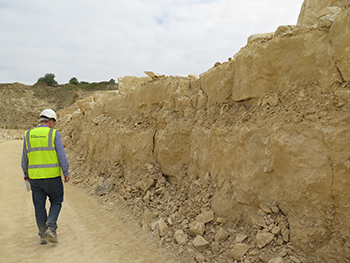
This is a free, online database of England’s building stones, their sources and representative structures. You can interrogate the GIS system and download data spread sheets and guides for each county.
Working with the British Geological Survey and consultants, Historic England's Strategic Stone Study project to collect all the data for all the English counties will be finished in March 2020.
We’d really appreciate your feedback about your experience of using it. You can do this by completing this short online survey.
Thank you for your support.
Metals and Decarbonisation Science Briefing Paper
Metals and decarbonisation: a geological perspective
Metals are fundamental to human existence. They perform a myriad of functions, including enabling the technologies needed to decarbonise the global economy such as low carbon energy generation and zero emission transport. However, humans use metals in vast quantities and their extraction and processing have profound environmental consequences, particularly in the emission of greenhouse gases. The Metals and Decarbonisation Science Briefing Paper summarises the current paradigm for global metal supply and demand, and sets out some of the barriers and opportunities that this presents to the transition to a more sustainable, low carbon economy.
Mineral Planning Factsheet Construction aggregates updated
BGS publishes a series of Mineral Planning Factsheets that cover economically important minerals that are extracted in Britain. Individual factsheets are periodically updated to provide an up-to-date overview of the supply of a specific mineral. They are primarily intended to inform the land-use planning process but will be of much wider interest. This is the latest update for the construction aggregates factsheet and reflects the many recent changes in the structure of the industry, the latest amendments in a wide range of aggregates-related planning issues, plus updated statistics on all aspects of aggregates supply.
Raw materials for a low carbon future
Batteries and fuel cells are enabling technologies for low emission vehicles and their adoption is forecast to grow exponentially in the coming years. Even though dependency on fossil fuels will be reduced, raw materials, in particular metals, will be needed in greater amounts for the manufacture of battery packs, fuel cells, electric vehicles and hydrogen-powered vehicles. Cobalt, lithium, graphite, nickel, manganese, platinum group metals, copper, rare earth elements and many more will be required to enable this transition.
The Briefing note on raw materials for batteries in electric vehicles presents some of the key issues associated with the demand and supply of key commodities, such as cobalt, lithium and nickel, as well as a discussion of potential mitigation actions.
Secrets in the Stone: The work of the BGS Building Stones team
Paul Everett from the British Geological Survey (BGS) building stones teams describes their work in helping to conserve the built heritage of the UK.
Mineral Commodity Profile – Lithium
A new addition to the series of mineral commodity profiles has been released. This series presents essential background information on individual mineral commodities for the non-specialist user. They are not intended to be highly technical but contain sufficient detail to enable the reader to gain a broad understanding of the particular mineral described.
Each profile summarises:
- the nature and geological occurrence of deposits
- extraction and processing methods
- specifications and uses
- world production, trade and prices
- the situation relating to the United Kingdom
This new addition relates to lithium, a mineral that most of us are aware of due to its use in lithium-ion batteries in our mobile phones and tablets. Lithium is also topical at the moment due to the increasing availability of electric cars, which all need batteries containing lithium. However, lithium has numerous other uses too; it is used in ceramics and glass, lubricating greases, air treatment, pharmaceuticals and optics, for example. Lithium is also unusual in that it comes from two very different sources: hard rock mining and the extraction of brine from beneath salt pans. The world's supply is dominated by Chile (brine) and Australia (hard rock) with just six other countries producing lithium in 2015. Download the profile here to read more.
European Mineral Statistics 2010-2014
This is the latest edition in the European Mineral Statistics series and provides essential information for the majority of economically important metals and minerals for 36 European Countries including European Union members, candidates and associates. It includes five year tables of production, exports and imports statistics arranged in two sections: by individual country; and by commodity with bullet points on salient features and graphics. It provides the essential background intelligence for any European minerals-related activities.
Risk List 2015
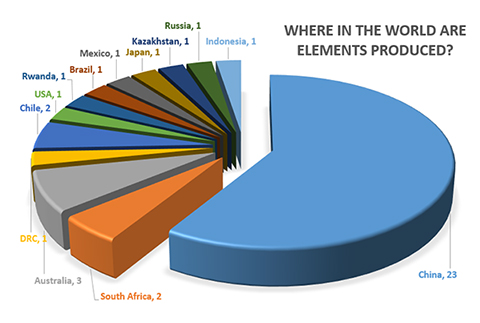
The Risk List, first published by the British Geological Survey in 2011, provides a quick indication of the relative risk to the supply of elements or element groups which we need to maintain our economy and lifestyle. This 2015 update shows that China is still the leading producer of a large number of mineral commodities, it also indicates that the minor metals (e.g. REE, Sb, Bi, Ge) continue to have the greatest potential risk of supply disruption.
Mineral Planning Factsheet: Metals
BGS has produced a series of Mineral Planning Factsheets that cover economically important minerals that are extracted in Britain. Individual factsheets are periodically updated to provide an up-to-date overview of the supply of a specific mineral. They are primarily intended to inform the land-use planning process but will be of much wider interest. The factsheet on Metals has been updated to reflect the recent revival of exploration in Britain, the opening of a major new tungsten mine in Devon and concerns over the long term availability of secure supplies of metals required by UK industry.



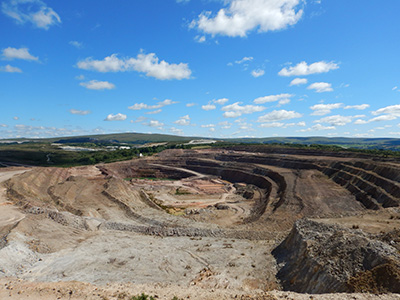
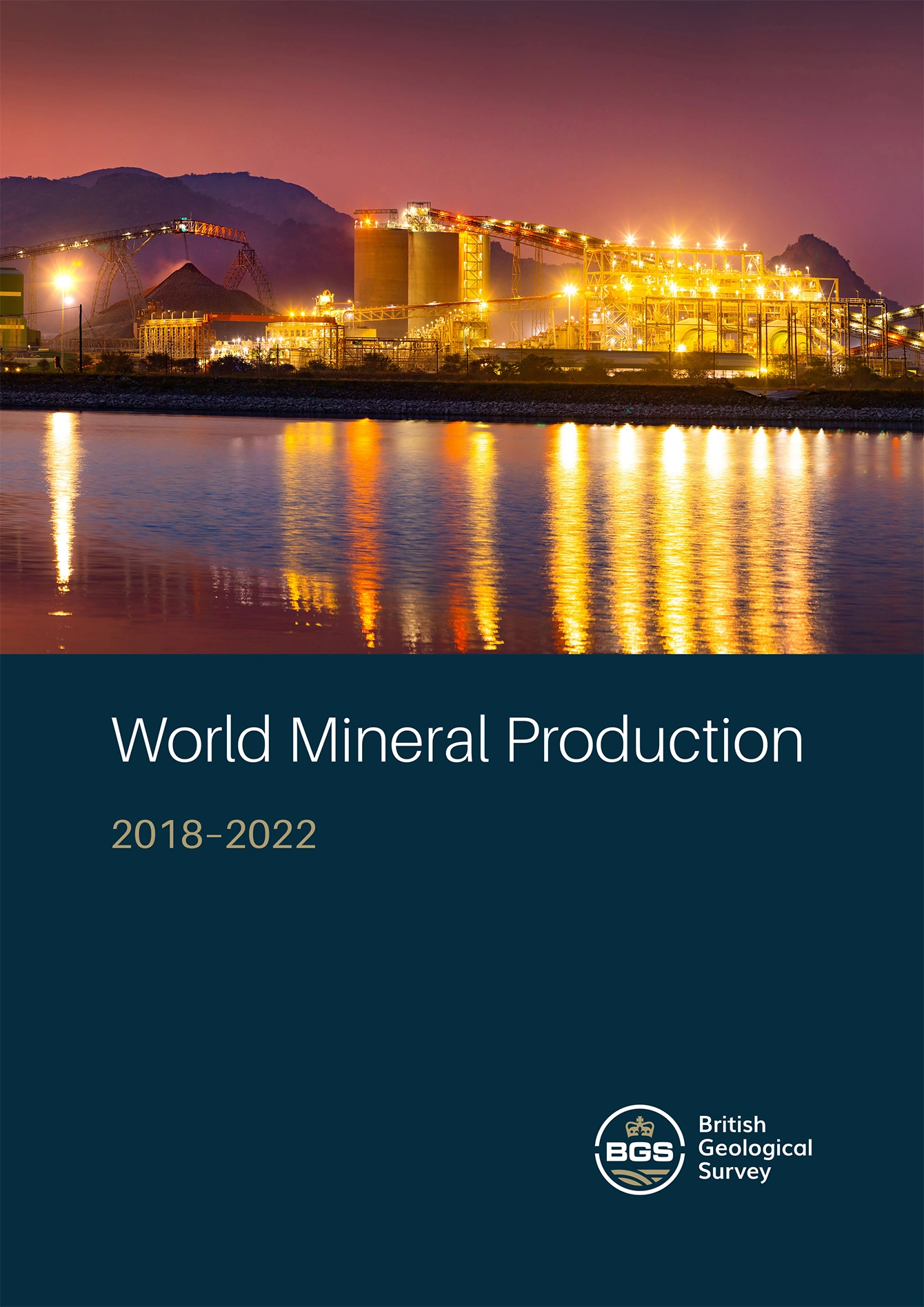
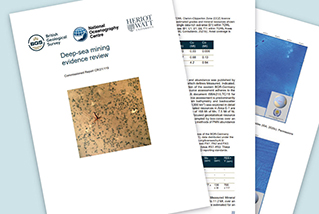

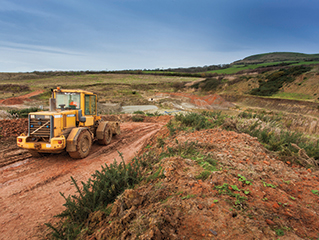
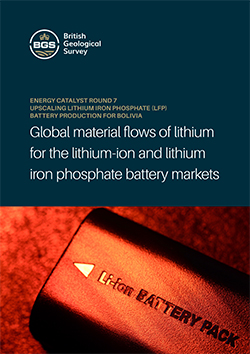
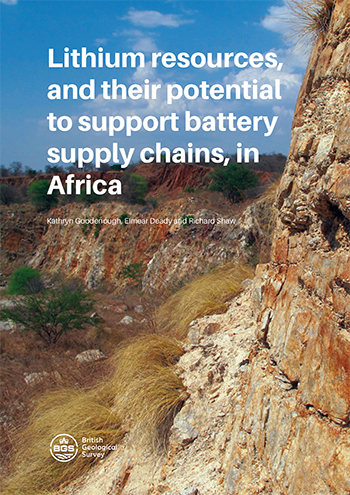
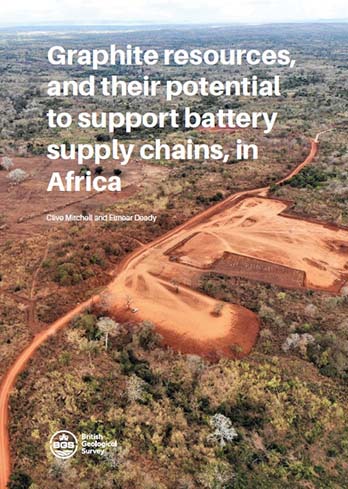
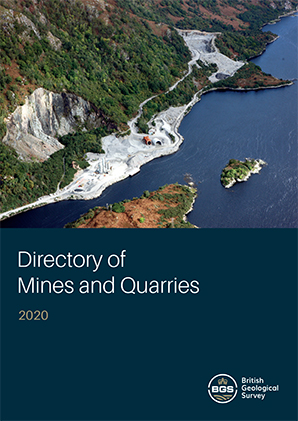

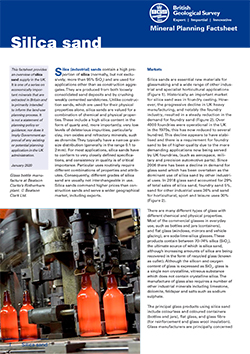
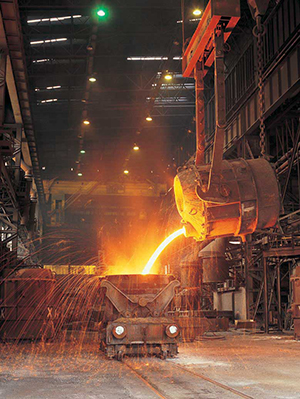
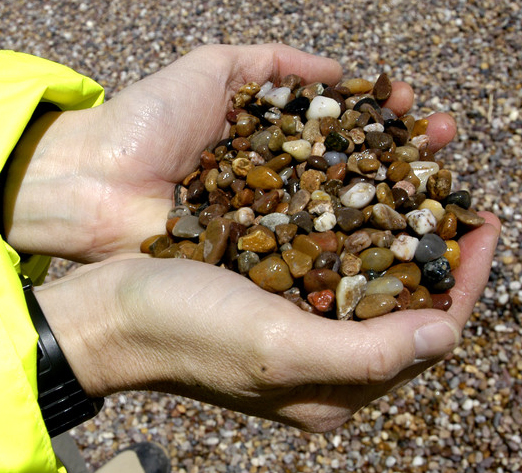
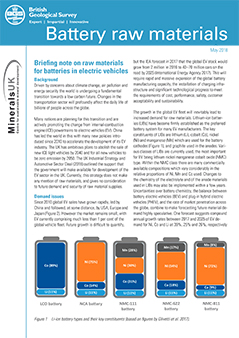
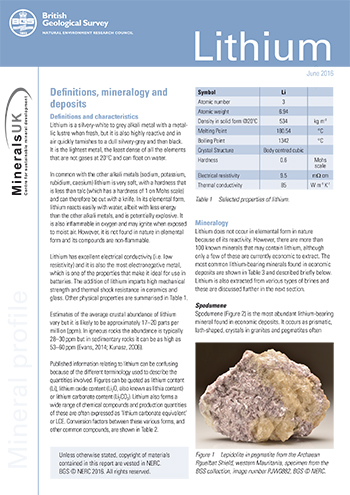
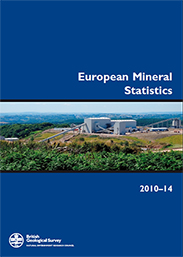
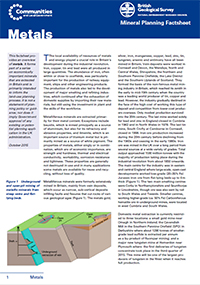

Follow us

